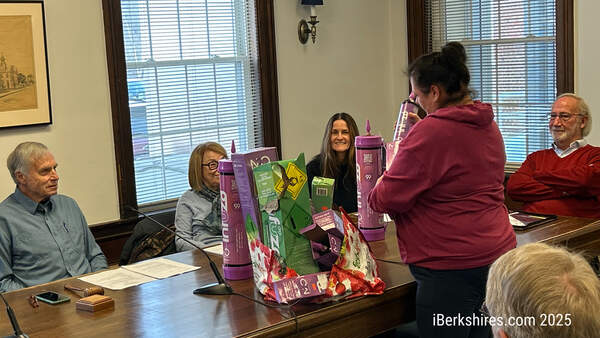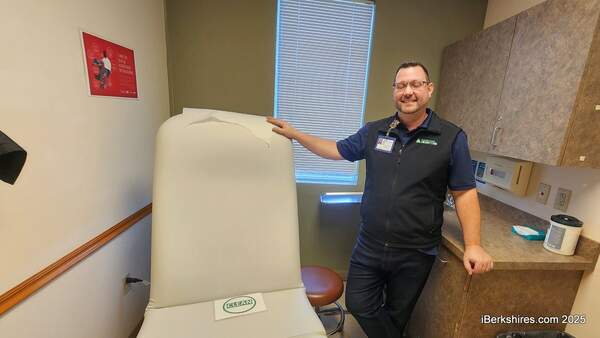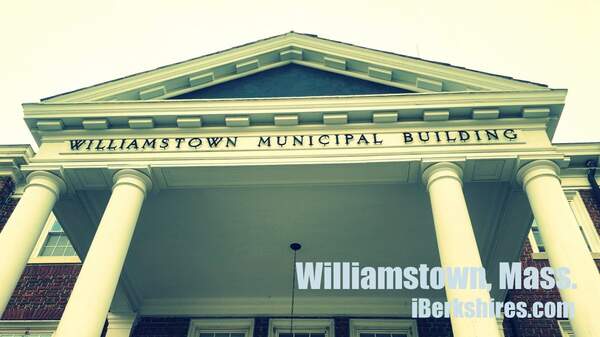Mount Greylock, Lanesborough Committees Discuss Hoosac Valley 'Proposal'
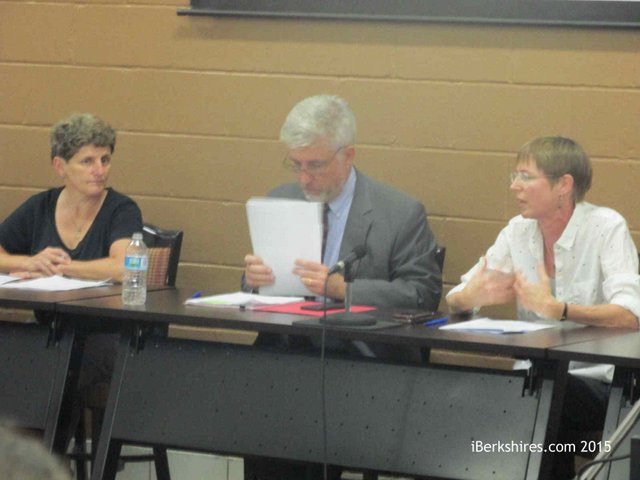 Lanesborough Chairwoman Regina DiLego, left, Superintendent Douglas Dias and Mount Greylock Chairwoman Carolyn Greene discuss the Hoosac Valley's attempt to entice Lanesborough away. Lanesborough Chairwoman Regina DiLego, left, Superintendent Douglas Dias and Mount Greylock Chairwoman Carolyn Greene discuss the Hoosac Valley's attempt to entice Lanesborough away. |
WILLIAMSTOWN, Mass. — The Mount Greylock Regional and Lanesborough Elementary school committees on Thursday talked about how they can stamp out "FUD."
"Fear, uncertainty and doubt," known by the three-letter acronym, is a term that has been used by School Committee member Richard Cohen to describe talk of breaking up Mount Greylock's two-town district and tuitioning Lanesborough students into Hoosac Valley High School.
"In the high-tech industry, when you don't have a good product and can't compete with your competition, you create chaos [to gain a marketing advantage]," Cohen said. "In this situation, we have people proposing ideas without knowing all the facts or voting on it.
"Based on those ideas being out there, we have the MSBA calling us."
Mount Greylock Chairwoman Carolyn Greene confirmed on Thursday that the Massachusetts School Building Authority has taken note of the various meetings that spun out of last month's letter from Adams Town Administrator Tony Mazzucco inviting Lanesborough to enter into talks about collaborating with the Adams-Cheshire Regional School District.
The MSBA has partnered with the Mount Greylock district on a building project that currently is developing a major addition/renovation project to address deficiencies in the 1960s era junior-senior high school.
"We've had several conversations with MSBA," Greene said. "[School Building Committee Chairman Mark Schiek] has been in the loop, [owner's project manager Trip Elmore] has been in the loop and several administrators. And there are concerns about what is going on and how this might impact the building project.
"My sense is that we need to get ahead of this thing."
Greene called the special meeting of the School Committee and invited the district's counterparts from Lanesborough Elementary and Williamstown Elementary. Scheduling conflicts prevented the Williamstown committee from achieving a quorum, but two members of the three-member Lanesborough committee, Chairwoman Regina DiLego and P.J. Pannesco, did attend.
The elected leaders of both districts agreed on two things: not enough information is available for Lanesborough residents to make an informed decision, and the specter of dissolution is too serious for Mount Greylock to ignore, particularly in the middle of the building project.
The district is on a tight timetable proscribed by the MSBA to complete its schematic design, nail down a final budget on the project and, if approved by the MSBA in December as hoped, get a bond question before voters in Williamstown and Lanesborough in early 2016.
Given the vague nature of the Hoosac Valley discussion and the promises by Adams officials that Lanesborough could save as much as $1.6 million under a tuition agreement, Mount Greylock officials fear that talk of "collaboration," which may or may not lead anywhere, could kill the building project either way
"These types of things take time, take years," Mount Greylock Superintndent Douglas Dias said, referring to the process of dissolving a district and hammering out a tuition agreement. "Every one of these issues could take weeks to pull apart."
"We don't have years," Cohen reminded his colleagues. "A 'years' time frame might work with [Lanesborough Town Administrator] Paul Sieloff's agenda."
Sieloff and the Lanesborough Board of Selectmen have repeatedly called for belt-tightening at Mount Greylock in recent years. The prospect of a bond issue to fund a renovated high school has heightened political tensions in the district.
"The timing [of the Hoosac Valley] proposal is no accident," Greene said. "We all know this is intended to throw a road block in front of the building project."
Greene started Thursday's meeting by suggesting the school committees propose a non-binding referendum for Lanesborough voters asking whether they want to pursue dissolution of the district.
The Mount Greylock School Committee already is planning to ask for a special town meeting in both towns in the fall to revise the regional agreement in order to create more equitable funding for capital expenses.
Not everyone at Thursday's meeting agreed that a non-binding referendum is needed, particularly since there is no formal proposal on the table.
"It's easy to say you can save money, but Lanesborough still needs a superintendent," she said. "It still needs a special education director. Once those children are floating around and have no high school, who is responsible for them? Once you have no high school to return to, you have no options."
Adams' Mazzucco told the audience at the forum that Lanesborough students could attend Hoosac Valley at a tuition rate of $8,700 per student.
There are two big problems with that number, the committees agreed: A. School committees, not town administrators, negotiate tuition agreements. B. There is no indication from Adams-Cheshire how long that $8,700 figure (if accurate) would be available.
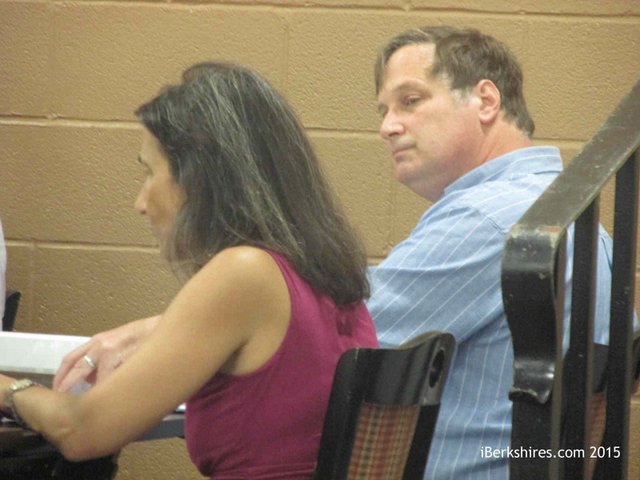 Mount Greylock committee members Wendy Penner and Richard Cohen at Thursday's joint meeting with the Lanesborough School Committee. Mount Greylock committee members Wendy Penner and Richard Cohen at Thursday's joint meeting with the Lanesborough School Committee. |
"Once you have no high school, you have no negotiating leverage," DiLego said. "Just as my town comes to my school committee and says, 'You need to do something about that tuition you're charging [to New Ashford], it's not enough,' what do you think is going to happen in Adams and Cheshire?"
Cohen and others speculated that not all Adams and Cheshire voters would be amenable to offering "deals" to Lanesborough.
"I know there will be objections," Cohen said. "I know there were objections a few years ago for a tuition agreement with Savoy that didn't take into account the capital costs [of Hoosac Valley's recent renovation]."
Cohen argued that the Mount Greylock School Committee should write the Adams-Cheshire School Committee and ask exactly what the terms of a tuition agreement might be.
"There is no proposal, as far as I'm concerned," Cohen said. "There's rumors of a proposal, there is discussion of a proposal, but the proposal isn't real.
"I would suggest the school committees, the boards of selectmen and the finance committees in each town deliberate on this."
And, Cohen said, Mount Greylock should ask for the answers by Oct. 1 so that the Mount Greylock and Lanesborough districts can properly assess their options.
The committees agreed to let Dias, DiLego and Greene draft such a letter.
They also agreed to form a task group to compose an op-ed piece to submit to local media that lays out the unresolved questions raised by the Hoosac Valley proposal.
Tags: ACRSD, LES, MGRHS, MSBA, regionalization,
 Lanesborough Chairwoman Regina DiLego, left, Superintendent Douglas Dias and Mount Greylock Chairwoman Carolyn Greene discuss the Hoosac Valley's attempt to entice Lanesborough away.
Lanesborough Chairwoman Regina DiLego, left, Superintendent Douglas Dias and Mount Greylock Chairwoman Carolyn Greene discuss the Hoosac Valley's attempt to entice Lanesborough away.  Mount Greylock committee members Wendy Penner and Richard Cohen at Thursday's joint meeting with the Lanesborough School Committee.
Mount Greylock committee members Wendy Penner and Richard Cohen at Thursday's joint meeting with the Lanesborough School Committee.

